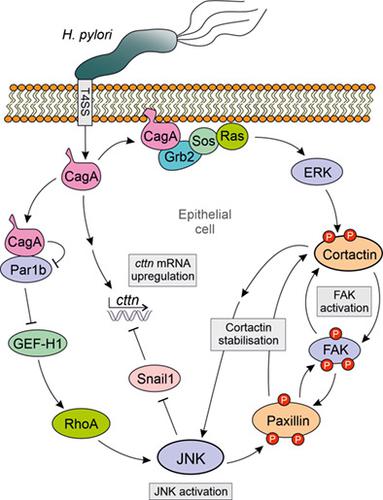当前位置:
X-MOL 学术
›
Cell. Microbiol.
›
论文详情
Our official English website, www.x-mol.net, welcomes your
feedback! (Note: you will need to create a separate account there.)
The Helicobacter pylori type IV secretion system upregulates epithelial cortactin expression by a CagA- and JNK-dependent pathway
Cellular Microbiology ( IF 2.6 ) Pub Date : 2021-07-01 , DOI: 10.1111/cmi.13376 Irshad Sharafutdinov 1 , Steffen Backert 1 , Nicole Tegtmeyer 1
Cellular Microbiology ( IF 2.6 ) Pub Date : 2021-07-01 , DOI: 10.1111/cmi.13376 Irshad Sharafutdinov 1 , Steffen Backert 1 , Nicole Tegtmeyer 1
Affiliation

|
Cortactin represents an important actin-binding factor, which controls actin-cytoskeletal remodelling in host cells. In this way, cortactin has been shown to exhibit crucial functions both for cell movement and tumour cell invasion. In addition, the cortactin gene cttn is amplified in various cancer types of humans. Helicobacter pylori is the causative agent of multiple gastric diseases and represents a significant risk factor for the development of gastric adenocarcinoma. It has been repeatedly shown that H. pylori manipulates cancer-related signal transduction events in infected gastric epithelial cells such as the phosphorylation status of cortactin. In fact, H. pylori modifies the activity of cortactin's binding partners to stimulate changes in the actin-cytoskeleton, cell adhesion and motility. Here we show that H. pylori infection of cultured AGS and Caco-2 cells for 24–48 hr leads to the overexpression of cortactin by 2–3 fold at the protein level. We demonstrate that this activity requires the integrity of the type IV secretion system (T4SS) encoded by the cag pathogenicity island (cagPAI) as well as the translocated effector protein CagA. We further show that ectopic expression of CagA is sufficient to stimulate cortactin overexpression. Furthermore, phosphorylation of CagA at the EPIYA-repeat region is not required, suggesting that this CagA activity proceeds in a phosphorylation-independent fashion. Inhibitor studies further demonstrate that the involved signalling pathway comprises the mitogen-activated protein kinase JNK (c-Jun N-terminal kinase), but not ERK1/2 or p38. Taken together, using H. pylori as a model system, this study discovered a previously unrecognised cortactin activation cascade by a microbial pathogen. We suggest that H. pylori targets cortactin to manipulate the cellular architecture and epithelial barrier functions that can impact gastric cancer development.
中文翻译:

幽门螺杆菌IV型分泌系统通过CagA和JNK依赖性途径上调上皮皮质素的表达
Cortactin 是一种重要的肌动蛋白结合因子,它控制宿主细胞中肌动蛋白-细胞骨架的重塑。通过这种方式,cortactin 已被证明对细胞运动和肿瘤细胞侵袭都表现出至关重要的功能。此外,cortactin 基因cttn在人类各种癌症类型中扩增。幽门螺杆菌是多种胃病的病原体,是胃腺癌发展的重要危险因素。已经反复表明,幽门螺杆菌在受感染的胃上皮细胞中操纵与癌症相关的信号转导事件,例如皮质素的磷酸化状态。事实上,幽门螺杆菌改变 cortactin 结合伙伴的活性,以刺激肌动蛋白-细胞骨架、细胞粘附和运动性的变化。在这里,我们显示H. pylori感染培养的 AGS 和 Caco-2 细胞 24-48 小时导致蛋白质水平上 cortactin 的过度表达 2-3 倍。我们证明了这种活动需要由cag致病岛 ( cag ) 编码的 IV 型分泌系统 (T4SS) 的完整性。PAI) 以及易位的效应蛋白 CagA。我们进一步表明,CagA 的异位表达足以刺激 cortactin 过度表达。此外,不需要在 EPIYA 重复区域对 CagA 进行磷酸化,这表明这种 CagA 活性以不依赖磷酸化的方式进行。抑制剂研究进一步表明,所涉及的信号通路包括丝裂原活化蛋白激酶 JNK(c-Jun N-末端激酶),但不包括 ERK1/2 或 p38。总之,使用幽门螺杆菌作为模型系统,这项研究发现了一种以前未被识别的微生物病原体的皮质素激活级联反应。我们建议H. pylori靶向 cortactin 以操纵可能影响胃癌发展的细胞结构和上皮屏障功能。
更新日期:2021-07-01
中文翻译:

幽门螺杆菌IV型分泌系统通过CagA和JNK依赖性途径上调上皮皮质素的表达
Cortactin 是一种重要的肌动蛋白结合因子,它控制宿主细胞中肌动蛋白-细胞骨架的重塑。通过这种方式,cortactin 已被证明对细胞运动和肿瘤细胞侵袭都表现出至关重要的功能。此外,cortactin 基因cttn在人类各种癌症类型中扩增。幽门螺杆菌是多种胃病的病原体,是胃腺癌发展的重要危险因素。已经反复表明,幽门螺杆菌在受感染的胃上皮细胞中操纵与癌症相关的信号转导事件,例如皮质素的磷酸化状态。事实上,幽门螺杆菌改变 cortactin 结合伙伴的活性,以刺激肌动蛋白-细胞骨架、细胞粘附和运动性的变化。在这里,我们显示H. pylori感染培养的 AGS 和 Caco-2 细胞 24-48 小时导致蛋白质水平上 cortactin 的过度表达 2-3 倍。我们证明了这种活动需要由cag致病岛 ( cag ) 编码的 IV 型分泌系统 (T4SS) 的完整性。PAI) 以及易位的效应蛋白 CagA。我们进一步表明,CagA 的异位表达足以刺激 cortactin 过度表达。此外,不需要在 EPIYA 重复区域对 CagA 进行磷酸化,这表明这种 CagA 活性以不依赖磷酸化的方式进行。抑制剂研究进一步表明,所涉及的信号通路包括丝裂原活化蛋白激酶 JNK(c-Jun N-末端激酶),但不包括 ERK1/2 或 p38。总之,使用幽门螺杆菌作为模型系统,这项研究发现了一种以前未被识别的微生物病原体的皮质素激活级联反应。我们建议H. pylori靶向 cortactin 以操纵可能影响胃癌发展的细胞结构和上皮屏障功能。











































 京公网安备 11010802027423号
京公网安备 11010802027423号